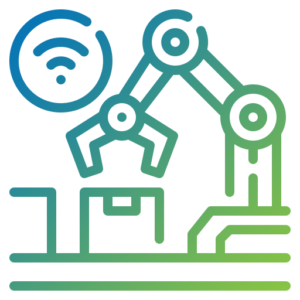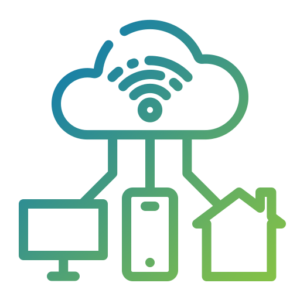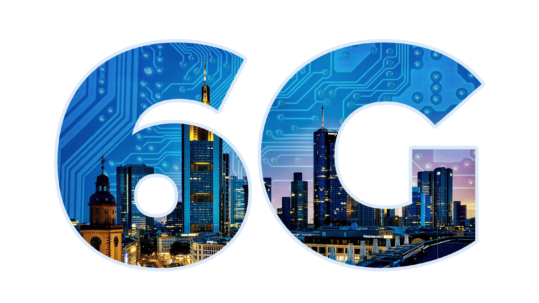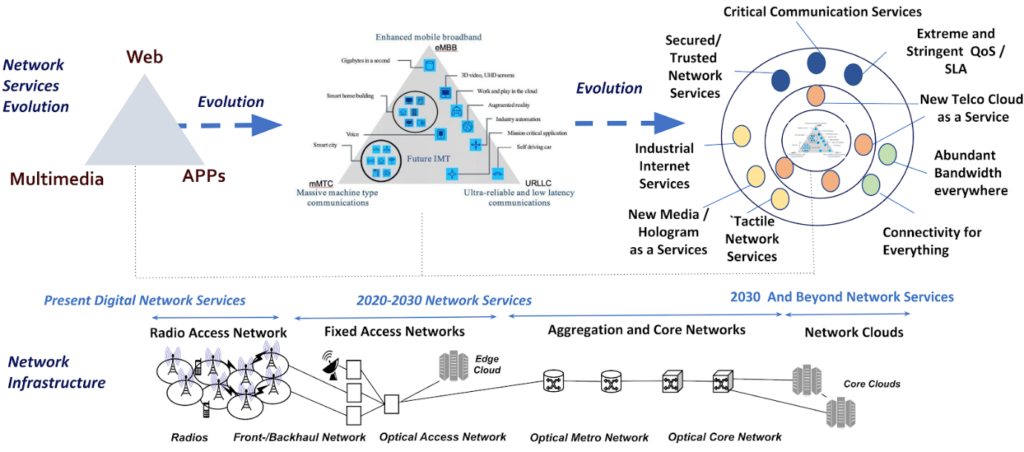The ITU introduced 5G targets resting on three main pillars: (i) very high data rates; (ii) massive connectivity; and (iii) ultra-reliable and low latency communications, serving three main types of network service segments, namely mobile broadband (eMBB), massive machine-type communications (mMTC), and ultra-reliable and low-latency communications (URLLC), also referred to as mission-critical communications [Popovski et al., 2018]. At the outset of 5G commercialization, the ambitions towards these targets were raised in concepts developed in 3GPP Rel. 16 and further examined in Rel. 17, thereby selling the vision of a fully connected ecosystem. Herewith, the main driving forces are so-called vertical applications, which include (but are not limited to):

synergistic integration of intelligent multisensory industrial operations and integrated robotics for process automation and smart manufacturing for the Industry 4.0 that may interchangeably include (i), (ii) and (iii) targets;

high-quality and high-immersive AR/VR (Augmented and Virtual Reality), i.e. XR (Extended Reality), gaming and holographic telepresence; also including tactile experience in addition to audiovisual communication for communication, education and entertainment that may mainly include (i) and (iii) targets;

very-high throughput in V2X (Vehicular-to-Everything) and very high connectivity density and high-precision positioning in highly dynamic and densely populated areas in Intelligent Transport Systems (ITS) and smart-cities that may also interchangeably include (i), (ii) and (iii) targets.
En route from 5G to 6G, new application areas will appear, calling for new capabilities in the networks. Together with their respective application domains, verticals bring unforeseen requirements to the underlying network compared with previous mobile communication generations that, so far, largely addressed typical mobile broadband applications such as video streaming in 4G. Thus, the envisioned technology-mediated experiences in some of the expected 5G/6G applications, including the connection of virtual and real-world environments, require an unprecedented multi-disciplinary combination of cloud, network, software and hardware as well as Quality of Experience (QoE) assurance, to effectively deliver these services at scale.

Therefore, these demands will require an architectural reshaping of the network that takes full advantage of i) the cloudified network environment brought by virtualization to facilitate, e.g., decoupling of processing capabilities and software products that provide network services, ii) the openness of network visibility and configuration to verticals that enables new capabilities, e.g., enhanced network verification, troubleshooting and resources’ description, iii) the automation of network management through Artificial Intelligence (AI) that make network automation and management less human-centric and more service-oriented, and iv) innovations in software and/or hardware processing offloading with COTS (Common Of-The-Shelf) hardware having a central role, e.g., with the exploitation of physical and virtual specialized hardware resources GPU (Graphics Processing Unit), APU (Accelerated Processing Unit), or Tensor Processing Unit (TPU).Instead of the black-box application and network interaction, in SMARTNESS we aim at building an application-network aware approach. Thus, this approach has the goal to demonstrate how new applications and application architecture requirements can be brought closer and translated into network resources [Lachos et al., 2020]. Thus, we will develop mechanisms that facilitate application semantics description and its translation into network resources, taking advantage of the aforementioned newly introduced architecture aspects, i.e., items i) – iv). Initially, we will decompose selected verticals from application domains into Network Function(s) (NF) and/or Network Service(s) (NS) capabilities, defined by a functional and behavioural specification. In other words, an NS behaviour will refer to a set of actionable network resources (e.g., communication, compute, and storage resources), with the goal of creating, providing or delivering a service. Thus, the end-to-end NS behaviour is the result of the combination of the individual NF behaviours and the behaviours of the network infrastructure composition mechanisms. As such, NS deployment descriptors may include, e.g., service topology, service characteristics such as Service Level Agreement (SLAs), among others, for the NS on-boarding.
The figure illustrates the NS evolution from the present (traditional) digital network services dominated by Web, Multimedia and over-the-top Applications, over 5G services offered as network slices tailored to heterogeneous requirements and characteristics of three types of applications (eMBB, mMTC, and URLLC) to services beyond 5G evolution offered by telco clouds that are extremely flexible and highly programmable end-to-end, connect-and-compute infrastructures. The envisioned network service platform infrastructures are both application and service-aware, as well as QoS/KPIs guaranteed-, time-, location- and context-aware. The network and compute infrastructure should support the interworking mechanisms and abstractions to instantiate smart networks and services beyond 5G, with KPI guarantees and components that can be deployed as virtual nodes within end-to-end precision slices, a vision beyond the state-of-the-art in network slicing [Galis et al., 2020].

Next, we present two illustrative use cases as examples of driving applications of technologies in scope of SMARTNESS that will help humans to remotely perform tasks, where issues like time zones, duplicate factory plants performing the same tasks, education / training or adversarial health conditions such as the global COVID-19 pandemic being significantly mitigated.
Industries of the future foresee a more synergistic integration of computation, communication, and physical processes [5GPPP, 2015]. This synergy includes communication and interactions between humans and machines, and machines with machines in working routines, where competitiveness is critical to manufacturers, and much-needed gains in efficiency and profitability will have to be achieved through new process innovations. More concretely, this includes the continued automation of robots and warehouse transportation and cutting cables to become truly wireless and flexible. The possibilities and choice of use cases in manufacturing intelligence are enormous. As key technology enablers, next-generation radio technologies (5G and beyond) and IoT stay right at the center of this transformation. In this context, typical smart factory use cases require low latency, high reliability, high bandwidth and connection density for ubiquitous connectivity. Thus, technologies must allow for higher flexibility, lower cost, and shorter lead times for factory floor production reconfiguration. We envision that SMARTNESS will provide key insights and technology proposals to put in place Service-Level Agreements (SLA) around end-to-end industrial operation use cases, thus enabling tailored connectivity for applications like e.g. remote operation of a robotic arm. Our goal is to propose and validate key technology components that help primarily to build an SLA-committable network that is customizable for verticals such as smart factories (which currently cannot rely on best-effort Internet access), smart grid applications, smart cities, etc.
Education and training with communication and interactions between humans can be revolutionized with enhanced remote collaboration [Araújo et al., 2018]. An application with audio, video and tactile communication can make access to education less dependent on resources, travelling and more democratized. Also, workers can be better remotely trained, reducing climate side-effects of travelling and logistics costs. The tactile aspect (e.g. XR applications) is particularly important for education and training in highly specialized craftsmanship (with few masters and apprentices), where the accurate encoding and transport of motion is critical to convey the ideal motion sequence for performing a particular work step. A key question to skill transfer is the effect of the network as well as the haptic control loop on the Quality-of-Learning (QoL). First, the metrics of QoL should be studied and compared against typical QoS or QoE metrics. In a second step, dynamic adaptation of the haptic codec and the network can be developed to improve the learning quality under varying network characteristics and task requirements. Third, how the design and use of cloud network digital twins for training and streamlined continuous integration (CI) / continuous development (CD) should be pursued.






